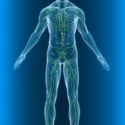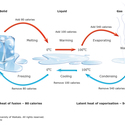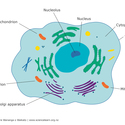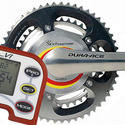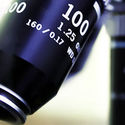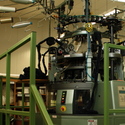Scientists at Victoria University of Wellington are making new shapes of nanoparticles. These will help reduce poisonous1 emissions from car exhausts by making catalytic converters in cars more efficient.
Catalytic converters
Dr Richard Tilley and PhD2 student John Watt are working to increase the efficiency of catalysts used in car catalytic converters.
Catalytic converters clean up car exhausts before letting the gases3 into the atmosphere4. One of the processes is to convert poisonous carbon monoxide5 to carbon dioxide6. Exhaust passes over a surface coated in platinum7 catalyst8 nanoparticles. Carbon monoxide and oxygen9 bind to this surface, where they join to form carbon dioxide. This carbon dioxide only has weak bonds with the platinum, so it is released. The platinum is then available to repeat the process.
Platinum also helps to reduce harmful emissions of oxides of nitrogen10, by changing them to nitrogen and oxygen gases. When a nitrogen oxide11 or nitrogen dioxide12 molecule13 meets the catalyst, the catalyst grabs the nitrogen atom14 and frees the oxygen. The nitrogen atoms bond with others stuck on the catalyst and are released as nitrogen gas.
Nature of science
There is normally more than one way of tackling a science problem. While Richard and John work on the shape and activity of platinum to increase efficiency, Richard Haverkamp and others at Massey University are investigating gold15 and other metals to replace platinum. Japanese scientists are investigating embedding the platinum nanoparticles on the surface of nanoscale16 ceramic17 balls to reduce clumping at high temperatures.
Only about 10% of the platinum catalyst is active, which is a real waste because the metal18 is very expensive. This is partly due to the nanoparticles clumping together at high temperatures and so reducing surface area19. New, more active shapes of platinum and other catalysts, such as palladium20 and rhodium21, should increase the efficiency of catalytic converters. There will also be less waste of a very limited, expensive resource.
New shapes of nanoparticles
Richard and John are making new shapes of nanoparticles that increase the surface area of the particles. To be a catalyst, the surface area: volume22 ratio of the nanoparticles is important – the larger the surface area, the more atoms are available to join in a chemical reaction23.
It’s not just about surface area, though. Some of the crystal faces of nanocrystals are more catalytically active than others. Richard and John use chemicals24 called surfactants to increase the growth of just the more active faces, increasing the activity of the whole catalyst.
How do surfactants control size and shape?
Some of the chemical tools that make Richard and John’s work possible are surfactants. These are soap molecules25 with a water-loving (hydrophilic26) end and a water-hating (hydrophobic27) end.
When nanoparticles are made in solution, they are in the form of tiny crystals. They have regular arrangements of atoms, just like the larger crystals you are more familiar with, such as sugar and diamond. When left uncontrolled, atoms keep joining on to the nanocrystals, causing them to grow until they are no longer at the nanoscale. This is where surfactants come in.
Surfactants bind to the surfaces of the nanocrystals, surrounding them and stopping them from growing.
Surfactants can also be used to control the shape of nanocrystals. Surfactants bind to different crystal faces with different strengths. If a surfactant28 binds strongly to a crystal face, that face can’t grow. If a surfactant binds weakly to a face, that face can grow. Richard and John make use of this process to get some faces of nanocrystals to grow but not others. This means they can control the shape of the nanocrystals.
Related content
Chemical reactions and catalysts are two of the big science ideas that underpin this research story.
To explore the nanoscience29 connection, students can use modelling clay30 to construct catalyst nanoparticle shapes and calculate surface area:volume ratios with the aim of trying to develop a more efficient shape.
Useful links
Visit the The MacDiarmid Institute for Advanced Materials and Nanotechnology website.
Dr Jerome Leveneur, a Material Scientist from GNS Science and Associate Investigator for the MacDiarmid Institute for Advanced Materials and Nanotechnology31, explains how scientists can manipulate the surfaces of objects to make them interact differently with fluids like coffee in a coffee cup in this video from Science on a Napkin.
- poisonous: Capable of harming or killing by or as if by poison. A poisonous organism only delivers its toxins when eaten, touched or inhaled.
- PhD: Abbreviation of Doctor of Philosophy – a degree normally obtained after a concentrated period of research. This is the highest level of degree that involves supervision by academic staff at a university.
- gases: The state of matter distinguished from the solid and liquid states. Gases have the ability to diffuse readily and to become distributed uniformly throughout any container.
- atmosphere: 1. The layer of gas around the Earth. 2. (atm) A non-SI unit of pressure equivalent to 101.325 kPa.
- carbon monoxide: Carbon monoxide consists of one carbon atom and one oxygen atom. It is an odorless, colourless, tasteless, flammable gas.
- carbon dioxide: CO2 is a colourless, odourless, incombustible gas. It is a product of cellular respiration and combustion and is an essential component in photosynthesis.
- platinum: A transition metal in Group 10 of the periodic table – symbol Pt, atomic number 78.
- catalyst: A substance that increases the rate of a chemical reaction but is not permanently changed by that reaction. In living organisms enzymes are catalysts.
- oxygen: A non-metal – symbol O, atomic number 8. Oxygen is a gas found in the air. It is needed for aerobic cellular respiration in cells.
- nitrogen: A non-metal – symbol N, atomic number 7. Nitrogen is essential for life. It is a component of many molecules that make up cells, including DNA and proteins.
- nitrogen oxide: N2O. One of the six greenhouse gases identified under the Kyoto Protocol.
- nitrogen dioxide: Atmospheric gas that comes from the combustion of fossil fuels (coal, gas and oil), especially fuel used in vehicles. Nitrogen dioxide can have harmful impacts on the human respiratory system.
- molecule: Two or more atoms bonded together. The molecule of an element has all its atoms the same. The molecule of a compound has two or more different atoms.
- atom: The smallest possible unit of matter that still maintains an element’s identity during chemical reactions. Atoms contain one or more protons and neutrons (except hydrogen (H), which normally contains no neutrons) in a nucleus around which one or more electrons move.
- gold: A transition metal in Group 11 of the periodic table – symbol Au, atomic number 79.
- nanoscale: Refers to dimensions below 100 nm. Also refers to the small size, often only a few nm, at which the properties of a substance are different to properties of bulk material.
- ceramic: An inorganic non-metal material that can be shaped and hardened by firing at high temperature to form a hard, strong and endurable body.
- metal: Any of a category of elements that usually have a shiny surface, are generally good conductors of heat and electricity and can be melted or fused, hammered into thin sheets or drawn into wires (for example, copper).
- surface area: The total area of an object or surface.
- palladium: A transition metal in Group 10 of the periodic table – symbol Pd, atomic number 46. A silvery-white, ductile, malleable metal discovered in 1803, used as a catalyst.
- rhodium: A transition metal in Group 9 of the periodic table – symbol Rh, atomic number 45.
- volume: 1. The quantity of space occupied by a liquid, solid or gas. Common units used to display volume include cubic metres, litres, millilitres, tablespoons and teaspoons. (Volume can refer to a large quanity of something). 2. The degree of sound intensity or audibility; loudness.
- chemical reaction: A process in which one or more substances are changed into different substances.
- chemicals: Everything is made up of chemicals. All matter (anything made of atoms) can be called chemicals. They can be in any form – liquid, solid or gas. Chemicals can be a pure substance or a mixture.
- molecule: Two or more atoms bonded together. The molecule of an element has all its atoms the same. The molecule of a compound has two or more different atoms.
- hydrophilic: Hydrophilic substances have an affinity for water and readily absorb or dissolve in water (hydro = water, philic = fond).
- hydrophobic: Hydrophobic substances do not interact easily with water (hydro = water, phobia = fear).
- surfactant: A chemical wetting agent that reduces the surface tension between oil and water. Detergents and soaps are surfactants.
- nanoscience: The study of atoms, molecules and objects whose size is on the nanometre scale (1–100 nanometres).
- clay: A naturally occurring fine-grained material formed from the chemical weathering of feldspar minerals found in rocks.
- nanotechnology: Understanding and working with matter at the scale of atoms and molecules. 1 nanometre is a millionth of a millimetre.




